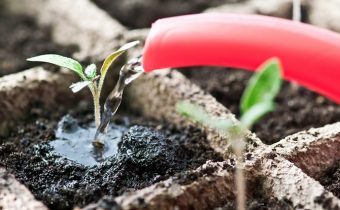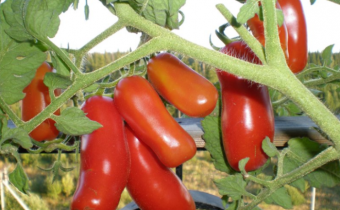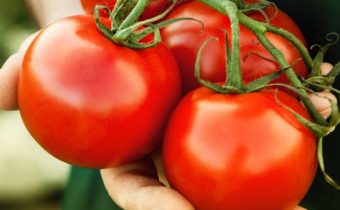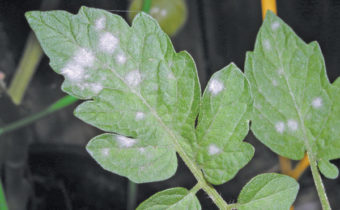Why does tomato seedling turn yellow and what to do about it?
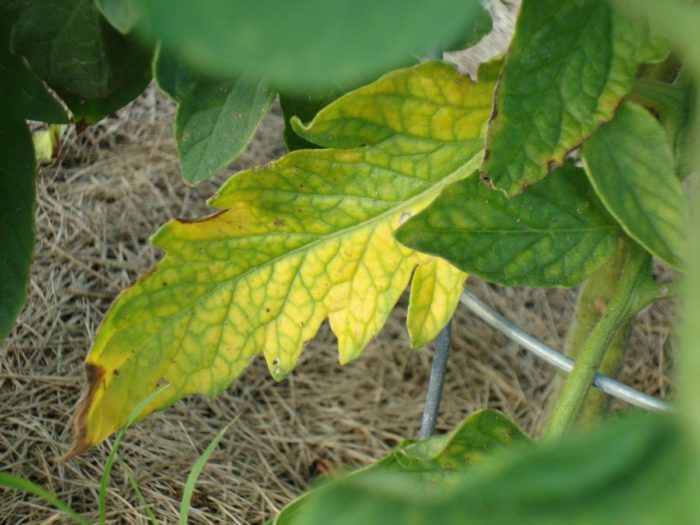
Tomatoes culture is very old. There is evidence that they were grown in the 8th century AD, the ancient Aztecs did it. Only hundreds of years later, vegetables came to Europe, while ancestors considered tomatoes a big berry.
What do you need tomato seedlings for growth?
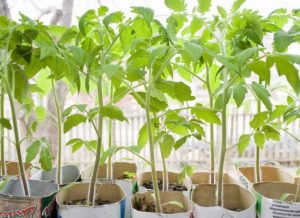 Newbies in suburban affairs often make many mistakes, which lead to a negative result. To seedlings grow from year to year and did not disappoint, you need to gain experience and knowledge. It is not enough to plant seeds in the ground from the garden to get seedlings. It is necessary to comply with all agricultural practices from the first stages.
Newbies in suburban affairs often make many mistakes, which lead to a negative result. To seedlings grow from year to year and did not disappoint, you need to gain experience and knowledge. It is not enough to plant seeds in the ground from the garden to get seedlings. It is necessary to comply with all agricultural practices from the first stages.
What to consider:
- soil nutritional value - it gives strength and immunity to future seedlings, which means that it is less affected by diseases, that is, tomatoes will not turn yellow, fade or blacken;
- light - from the school biology course we all know that light is necessary for plants, otherwise they just die. This is one of the main rules. There is not enough light - we need lamps so that the lighting is at least 10-12 hours a day;
- watering - even the child knows too. If the flowers or garden crops are not watered, the result will not take long. Water must be settled so that the soil does not accumulate heavy elements. Also, it should not be icy, so that the roots are not subjected to stress;
- top dressing - it is not enough just to plant the seeds in the nutrient soil, since the seedlings will soon pick up everything from the soil. Then there is a nutritional deficiency, immunity falls from here, and the seedlings start to hurt.
What can be concluded from the above? If you do not know why the leaves of tomato seedlings turn yellow, then it is worth reviewing all agricultural techniques and identifying shortcomings. If measures are taken in time, the seedlings can be easily saved and in the future get a good harvest. Let's take a closer look at everything in the next section.
Causes of tomato seedling yellowing
Feed Errors
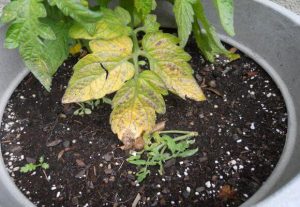 As you already understood, any culture is very sensitive to the nutritional value of the soil. Tomatoes to feed well respond, they love them. It is especially important to give regularly fertilizers to those varieties that grow high, have a powerful root system. Fertilizers must include a complex of elements in order to completely fill the entire deficit. If some mineral is not enough, then problems begin, among which is the yellowing of the leaves of the seedlings of tomatoes. But newcomers will immediately ask the question, how can you understand what exactly the seedlings lack? It's pretty simple.
As you already understood, any culture is very sensitive to the nutritional value of the soil. Tomatoes to feed well respond, they love them. It is especially important to give regularly fertilizers to those varieties that grow high, have a powerful root system. Fertilizers must include a complex of elements in order to completely fill the entire deficit. If some mineral is not enough, then problems begin, among which is the yellowing of the leaves of the seedlings of tomatoes. But newcomers will immediately ask the question, how can you understand what exactly the seedlings lack? It's pretty simple.
The main elements that are necessary for tomatoes are potassium, nitrogen, zinc, manganese, iron, copper, phosphorus. They must be in the best possible combination - of course, it’s difficult for you to make the perfect feeding yourself. But the complex drug is easy to buy in the store for gardeners.You can also solve the problem, when you already understand what kind of mineral is currently in short supply - replenish it with the help of appropriate fertilizer. About them will be a separate section. So, how to determine why the leaves of tomato seedlings turn yellow.
See also: Why are the leaves curled around a tomato in a greenhouse?
Deficiency of elements:
- if you notice that the foliage of the seedlings began to lose its green pigment, it turns yellow, regularly falls, and new leaves form small, then most likely the reason is a lack of nitrogen in the soil;
- if you see that young leaves on seedlings begin to curl, old ones lose color, yellow spots appear, then this is most often a lack of potassium in the ground;
- a magnesium deficiency can be indicated by the yellow color along the veins on the leaves;
- if the leaves first turn yellow together, after they even become white, then this is an iron deficiency;
- on the seedlings you see two types of spots - brown and yellow, then there is a shortage of zinc;
- about the manganese deficiency can suggest the following fact - the leaves turn yellow here and there, often in a checkerboard pattern, moreover, the process starts from the bottom.
These signs, upon careful consideration and observation, can even be seen by a novice for several days. As soon as you understand what element is in short supply, you need to fill it with a top dressing. As a rule, the situation will quickly begin to change for the better, because once again we will repeat that tomatoes are a very responsive crop of fertilizers. But only if the lack of fertilizers can cause a problem when the leaves of tomato seedlings dry. Of course not. Perhaps the reasons are much simpler.
Insufficient lighting
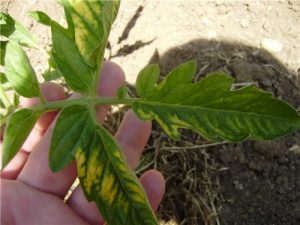 This problem is easy to identify and solve. We all know that there, where there is a lot of sun, places, moderately humid, all the plants - be they cultivated or just weeds, are fragrant. And vice versa. Tomatoes are very light-loving, of course, they can suffer from the sun's rays. It is optimal to put the seedlings on the southeast window, east or put it next, creating light lace penumbra.
This problem is easy to identify and solve. We all know that there, where there is a lot of sun, places, moderately humid, all the plants - be they cultivated or just weeds, are fragrant. And vice versa. Tomatoes are very light-loving, of course, they can suffer from the sun's rays. It is optimal to put the seedlings on the southeast window, east or put it next, creating light lace penumbra.
If the window is southern, there is a lot of sun on it, which starts to burn very strongly in the spring, besides the region is warm, then the seedlings may start to turn yellow, because they are hot. In addition, direct rays can burn tender seedlings, especially if she still lacks moisture. The easiest way to solve this problem is to remove the boxes with the tomatoes on another window or place them on the table so that there is a slight shade from the curtains, also watch the watering, the soil should not dry out and even lag behind the walls of the pot.
But the situation is different - what to do when tomato seedlings turn yellow with a lack of light? Make extra lighting.
Additional lighting lamps:
- sodium - include optimum spectrum for seedlings, very well help seedlings to grow. But such lamps require space and are not cheap;
- Fitolampa - ideal for plants on the spectrum, used in greenhouses, and at home, suitable for growing for sale. But this light is also not cheap, and also has a pink color that irritates the eyes. Optimal for those who grow seedlings in a separate room;
- fluorescent lamps - cheap and quite well suited for small growing seedlings. Lamps economical, but emit little red spectrum, as well as dangerous if broken. Also, a minus is a small area of coverage;
- diodes - a very good option, but not cheap. Diodes can be bought in any color, they are economical, safe and durable.
If you asked the question now, but is it not easier to put a simple incandescent lamp over the container, then do not rush to draw conclusions. No - incandescent bulbs are extremely unsuitable for seedlings, they do not radiate the spectrum they need, spend a lot of energy and also threaten tender seedlings. What lamps to choose, you decide. If you plan to deal with seedlings all the time, then immediately it is better to spend money once, but buy quality lighting.If you are a beginner and just try yourself, then take simple fluorescent lights.
Consequences of close planting seedlings
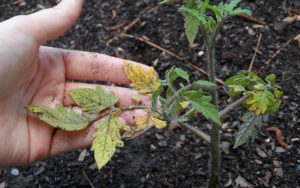 Well, everything is simple and easy to solve. If you often sow seedlings, dive after not into separate cups, then it is quite possible that the seedlings suffer from their own counterparts. Its roots are closely intertwined in the ground, which is important to take into account in the future during transplantation, so that there is no injury. A lot of seedlings in the tray and takes a lot of power, but about the shortage of elements, we have already told you. In addition, the seedlings obscure themselves and about this we also just mentioned.
Well, everything is simple and easy to solve. If you often sow seedlings, dive after not into separate cups, then it is quite possible that the seedlings suffer from their own counterparts. Its roots are closely intertwined in the ground, which is important to take into account in the future during transplantation, so that there is no injury. A lot of seedlings in the tray and takes a lot of power, but about the shortage of elements, we have already told you. In addition, the seedlings obscure themselves and about this we also just mentioned.
Excess plant often leads to an excess of moisture in the soil, then there can begin to develop disease, and the roots rot. The latter directly affects the leaves - they turn yellow, fall off, the seedlings wither and die. The solution is simple - plant seedlings more freely, and preferably in separate cups with new clean soil.
The soil
Of course, seedlings need very good soil. About the fact that it should be nutritious, you already understand. But that's not all. The earth must pass air well so that oxygen enters the root system, then it will develop well and feed the entire aboveground part. If the ground is heavy, you loosen it with difficulty, then it’s not too late to replace the soil with a new one. The error could be that you just took the soil from the garden, and you have it unsuitable. It is not enough to simply add additional fertilizing to the ground, it is necessary to add sand, peat or perlite to it for breathability. It also affects the content of excess water.
An important factor is the acidity of the soil. It is checked using litmus paper, which is sold in pharmacies, garden stores or on the Internet. Tomatoes do not like sour soil, like many cultures. pH is normally 6-6.5. If the soil is acidic, that is, the indicators are much lower than 6, then lime, chalk, fluff, dolomite flour are added, mixed, and again checked with paper.
But not only the acidic soil is bad for the seedlings, but also salty. Understand that you use salty soil, and it is bad for seedlings, can be due to the fact that on the surface of the earth appears white or yellow bloom. Seedlings better transplanted into a new soil. If you can not pick up the soil yourself, then just buy ready.
Wrong watering
Another very common and easily solved reason. Understand that you strongly fill the ground, you can by the fact that the soil you almost does not dry out, there was mold. Also a clear sign of the bay - it is the yellow seed leaves at the seedlings of tomato. From an excess of moisture begins to develop pathogenic environment, which leads to disease, rotting roots. Water the seedlings need as the soil dries out, every day it should be only slightly moist and well loose. It is impossible neither to flood the seedlings, or, on the contrary, to allow it to dry out when the soil moves away from the walls of the trays. Water need to defend the day.
See also: Spots appeared on the leaves of tomatoes, how to treat kladosporiosis?
Diseases
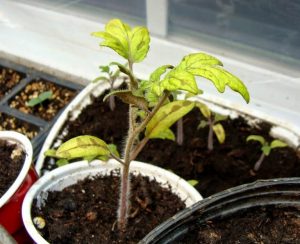 Of course, one of the frequent causes of the appearance of yellow leaves on fragile seedlings can be illness.
Of course, one of the frequent causes of the appearance of yellow leaves on fragile seedlings can be illness.
- Rot, which occurs on the background of excess moisture. The solution is to reduce watering or transfer to a new soil. Also, monitor the humidity of the room and temperature.
- Fusarium May also occur against the background of excess moisture and in the cold. Adjust the watering, temperature. Saplings are treated with “Phytosporin” two times in a row, after they take a break of 14 days and repeat the treatment again.
- Late blight. If the leaves began to turn yellow and brown spots appeared, then immediately spray them with a solution of salt - 1/2 tablespoon of salt per liter of water.You can apply a solution of the drug "Trichopol" in water. 10 tablets on a bucket and pour 15 ml of green stuff here. The same tool can carry out the prevention of ailments during flowering.
What to do if the leaves of tomato seedlings turn yellow
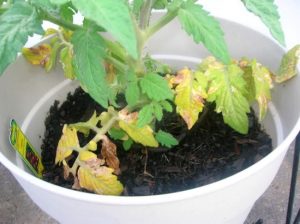 Let's summarize all of the above. You already know why tomato seedlings turn yellow, and you could understand what to do. We will cover the shortage of one or another element in the last section, in all other cases, everything is rather simple.
Let's summarize all of the above. You already know why tomato seedlings turn yellow, and you could understand what to do. We will cover the shortage of one or another element in the last section, in all other cases, everything is rather simple.
- If you poured saplings, it is advisable to remove the seedlings from the ground and assess the damage on the roots. After that, transplanted into a new, well-drained and nutritious composition.
- Observe the temperature in the room within 23-26 degrees.
- If you notice yellowing, then you can immediately feed the seedlings with a complex preparation, if you know for sure that the reason is not in acidity, not in the gulf.
- If the earth is acidic, you will have to transplant it into a new soil, having previously checked it with a litmus.
- If the seedlings began to turn yellow after picking, then pritenite it and only occasionally water it, let it grow stronger.
- If the seedlings are close, then rather divide them, and remember that the light must be thought out in advance.
Top dressing for seedlings tomato
Urea
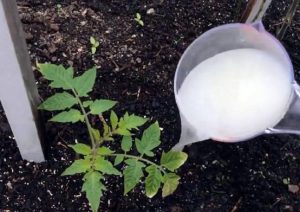 This tool will help to form a good above-ground part or simply green plants. The fact is that urea contains a lot of nitrogen - more than 45%. She begins to feed the seedlings after germination, then every 14-20 days. After picking, they are kept for 10-14 days for planting. Sold in stores in the form of white balls. Approximate consumption - 20-30 grams per bucket of warm water.
This tool will help to form a good above-ground part or simply green plants. The fact is that urea contains a lot of nitrogen - more than 45%. She begins to feed the seedlings after germination, then every 14-20 days. After picking, they are kept for 10-14 days for planting. Sold in stores in the form of white balls. Approximate consumption - 20-30 grams per bucket of warm water.
Pros:
- affordable price;
- high nitrogen concentration;
- very fast effect;
- simplicity and versatility in use;
- prevention of ailments;
- possibility of use for foliar nutrition.
Minuses:
- nitrogen should not be given to plants during flowering and after, otherwise the fruit will not be tied;
- it is important to observe concentration, since seedlings can get burned;
- slightly acidifies the soil.
Manganese solution
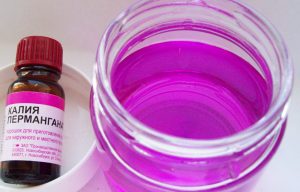 With them you can fill exactly the deficit of manganese in the soil. Used as foliar spraying - once every 7-10 days the entire growing season. The solution should be slightly pinkish.
With them you can fill exactly the deficit of manganese in the soil. Used as foliar spraying - once every 7-10 days the entire growing season. The solution should be slightly pinkish.
Pros:
- serves as an excellent prevention;
- budget facility;
- disinfects;
- can always be used, and also for soil dressing.
Minuses:
- high concentrations can kill plants.
Ash
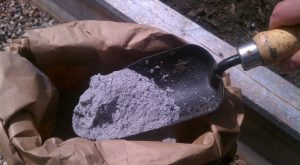 One of the oldest and most popular tools. Wood ash contains several elements at once - potassium, calcium, magnesium, sodium, phosphorus and others in smaller quantities. The recipe may look like this - a glass of ash is dissolved in a bucket of water, kept for 2 days. You can spill the area and use for spraying.
One of the oldest and most popular tools. Wood ash contains several elements at once - potassium, calcium, magnesium, sodium, phosphorus and others in smaller quantities. The recipe may look like this - a glass of ash is dissolved in a bucket of water, kept for 2 days. You can spill the area and use for spraying.
Pros:
- budget facility;
- ecologically clean;
- filling the shortage of several elements at once;
- prevention of ailments and parasites;
- safe for humans and plants.
Minus:
- can not be used as a complete feed, it is better to combine ash with organic matter;
- the effect of feeding is quite short, you will have to make it often.
Potassium nitrate
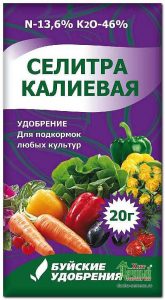 This dressing contains not only potassium, which is needed for seedlings and future fruits, but also phosphorus and nitrogen. Feed nitre and seedlings, and bushes in the garden beds. Norm 1% solution, feeding combined with irrigation. Bred 10 grams per bucket of water.
This dressing contains not only potassium, which is needed for seedlings and future fruits, but also phosphorus and nitrogen. Feed nitre and seedlings, and bushes in the garden beds. Norm 1% solution, feeding combined with irrigation. Bred 10 grams per bucket of water.
Pros:
- well helps to fill the deficiency of elements;
- you can use the entire growing season;
- affordable price;
- prevention of ailments.
Minuses:
- it is necessary to observe strict concentration and precautionary measures, as it is possible to get poisoning.
See also: Why do green tomatoes rot in the bushes in the greenhouse, and how to save the crop?
Complexes
In conclusion, we will also advise you to look at the following comprehensive feeding, examining the question of why tomato seedlings are yellow, and what to do:
- "Kimira Lux" - can be in a dry form and in the form of a solution - 1/2 tablespoon per tablespoon per bucket of water;
- "Fitosporin" - is available in different variations. Proportions are most often 1/2 with water;
- Agricola is one of the most popular complexes. Dilute 25 grams per bucket of water;
- “Health” - the norm for watering at the root of 15 grams per bucket of water, for spraying - 10 grams per bucket of water;
- Iodine - ordinary iodine is used for spraying every two weeks at the rate of 5 drops per bucket of water;
- "Kornevin" - a popular feed for the roots. Bred 10 grams per 10 liters.
We hope we have answered all your questions. The main thing is to take all necessary measures in time, and then your seedlings will be saved.
Video: Why the leaves of tomato seedlings turn yellow and dry


